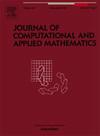解决标准非线性伪单调方程和逻辑回归问题的基于两步放松惯性无导数投影算法
IF 2.6
2区 数学
Q1 MATHEMATICS, APPLIED
Journal of Computational and Applied Mathematics
Pub Date : 2024-10-09
DOI:10.1016/j.cam.2024.116327
引用次数: 0
摘要
本文探讨了一种两步惯性无导数投影方法,该方法采用松弛因子γ∈(0,2)求解非线性伪单调方程。与现有的非线性伪单调方程系统的惯性算法不同,我们方法的惯性步骤涉及当前迭代点和前两个迭代点。特别是,其中一个惯性参数为非正值。在所提出的算法中,搜索方向不仅具有充分下降特性,还具有信任区域特性,与直线搜索技术无关。此外,我们还确定了算法的全局收敛性和收敛速率,而无需底层映射的 Lipschitz 连续性。最后,与文献中已有的两种惯性算法相比,我们的方法在标准非线性单调和伪单调方程以及逻辑回归问题上提供了有竞争力的结果。本文章由计算机程序翻译,如有差异,请以英文原文为准。
A two-step relaxed-inertial derivative-free projection based algorithm for solving standard nonlinear pseudo-monotone equations and logistic regression problems
This paper explores a two-step inertial derivative-free projection method with a relaxation factor for solving nonlinear pseudo-monotone equations. Unlike existing inertial algorithms for the system of nonlinear pseudo-monotone equations, the inertial step of our method involves the current iteration point and the previous two iteration points. In particular, one of the inertial parameters is nonpositive. In the proposed algorithm, the search direction possesses not only the sufficient descent property but also the trust region property, independent of the line search technique. Moreover, we also establish the global convergence and the convergence rate of the algorithm without the Lipschitz continuity of the underlying mapping. Finally, our method provides competitive results on standard nonlinear monotone and pseudo-monotone equations and logistic regression problems compared with two inertial algorithms existing in the literature.
求助全文
通过发布文献求助,成功后即可免费获取论文全文。
去求助
来源期刊
CiteScore
5.40
自引率
4.20%
发文量
437
审稿时长
3.0 months
期刊介绍:
The Journal of Computational and Applied Mathematics publishes original papers of high scientific value in all areas of computational and applied mathematics. The main interest of the Journal is in papers that describe and analyze new computational techniques for solving scientific or engineering problems. Also the improved analysis, including the effectiveness and applicability, of existing methods and algorithms is of importance. The computational efficiency (e.g. the convergence, stability, accuracy, ...) should be proved and illustrated by nontrivial numerical examples. Papers describing only variants of existing methods, without adding significant new computational properties are not of interest.
The audience consists of: applied mathematicians, numerical analysts, computational scientists and engineers.

 求助内容:
求助内容: 应助结果提醒方式:
应助结果提醒方式:


